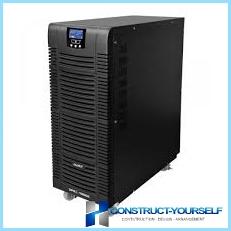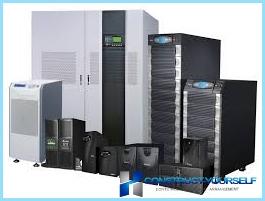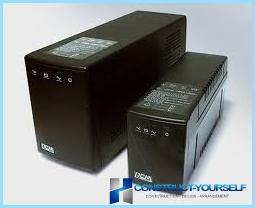The contents
Despite the forward-moving progress, the lack of electricity increases every year. And this happens not only in remote villages but also in big cities, even with its hydroelectric power station. Why is this happening? The answer is very simple. A growing number of powerful consumers, which previously did not exist. Network, designed in the USSR, has not changed. Here, in order not to overload the line at peak hours of power service disconnect of consumers of the third class, i.e. houses. And this happens often without warning. Sit on the Internet or in front of the TV, and BAM…! the lights went out. In such a situation, except nerves, can be damaged expensive appliances, but will not find extreme.
But there is a solution. To purchase the UPS for the house. What are they and how they work — these and other questions, the answers to them, are discussed later in the article.
Appointment ↑
The main task of UPS is the supply of a house or apartment when you disconnect or crash on the main energolinija. When voltage is applied in a core network, the UPS automatically, without human intervention, switch the power back on this line. In addition, the UPS is protected against voltage drops and stabilizes it:
The UPS types ↑
- UPS — backup. It is most commonly used uninterruptible power supply. This is due to: low cost, high efficiency and low heat. The disadvantage of this device type is: slow switching from line to battery, poor input and output EMC filter, switching power supply of the load with little voltage fluctuations. This leads to premature wear of the relay contacts and frequent replacement of batteries.
- Line-interactive UPS. With higher switching speed than the first. Equipped with a device for automatic adjustment of mains voltage. This device to the latest attempts to stabilize the voltage, and only when this fails, it switches power to the battery. Hence, long-lasting functioning of all units and blocks, as well as the high cost of UPS.
- Online UPS. The most expensive type of UPS. The switching of the power sources takes place almost without delay. Used in industrial structures at critical facilities, such as PBX and server.
Performance ↑
UPS are different type of performance. Some batteries are built into one Cabinet with other units, others, batteries are separate and additional connecting cable. What are the differences, pros and cons of such designs?
If the UPS is of small capacity, then the batteries are usually small and located in the same Cabinet with inverter and charger. Plus this design — takes up little space and mobility. Minus — in the case of replacement, you must put the same battery, which is not always possible to find. There is no way to increase the time of work, replaced by a more capacitive battery.
Another thing is the UPS with external battery. Here you can experiment with. Besides the external battery can be placed in a separate, well ventilated room with a stable temperature. Because batteries can release harmful fumes and does not tolerate extremes of temperature.
UPS ↑
Virtually every source of power consists of such blocks as:
- the input filter;
- rectifier;
- charger;
- battery;
- inverter;
- switching device;
- control devices;
- output circuits;
- case.
The input filter consists of capacitors and coils, which remove the interference of the network, and at the same time suppress your from the inverter.
The rectifier converts the AC voltage of 220 Volts DC needed to operate the charger unit and inverter. The rectifier consists of a diode bridge electrolytic capacitors and additional elements that enhance the smoothing of the current.
Charger. It is composed of electronic components, regulating and controlling the optimum battery charge.
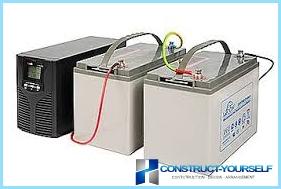
The battery is simply necessary in this device. In the event of a power failure in the network, they power the inverter, which generates a voltage emergency. It is the quality and capacity of the batteries depends on the operating time of the UPS while disconnected common network.
The inverter consists of a pulse generator of predetermined frequency which includes a primary winding of the transformer, arousing in it a magnetic field. From the secondary winding the voltage is removed, which is rectified and stabiliziruemost. It is used to power electrical appliances at home. Through this long journey of change, current output has the correct form and high stability. Home equipment protected from power surges and fluctuations.
Switching device is composed of a fast relay that disable the network quickly switches from one power source to another.
Control devices depending on the UPS model, can be both electronic and mechanical voltmeters, and ammeters. Thanks to them, it is possible to control the voltage and current as input and output devices.
The output circuit is the same as on the input of inductors and capacitors clears away the clutter. In addition to the above is the output clips or terminals for connection of home electrical.
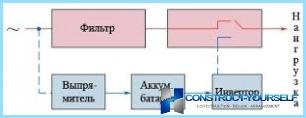
Of course to protect all the blocks you need a reliable and aesthetically pleasing housing. Different models, the case has its own peculiarities. Therefore, choosing a UPS, you should pay attention to the material if there are enough slots for cooling the internal blocks and the color of course, if someone this is important.
The principle of operation ↑
As already partially described above, the principle of operation is as follows:
- AC voltage is rectified by the rectifier;
- the rectified DC voltage used for battery chargers and inverter power;
- the rectifier charges the batteries, which when you disconnect the feed the inverter;
- the inverter in turn generates a network of stable AC voltage of 220 Volts.
Installation and connection of UPS for home ↑
The connection is not difficult. To each unit there is an instruction with the scheme and the recommendations of the connection and installation. In any case, the input device cable is connected directly from the output of the counter, and the output from the UPS to your network at home. That is simply the UPS is installed in the gap between the meter and the home network. To put the device, if it does not interfere directly in the hallway of a private house near the meter and all connections to make at the least way. This is the easiest option. If lost aesthetics, you have to put the UPS where it does not spoil the view, and input and output cable to counter.
Sometimes in the scheme include more gasoline or diesel generator, which of course should stand alone in non-residential premises or on the street. Use it when the battery has exhausted its charge, and the electricity never filed. The generator will additionally give energy and charge batteries.
How to choose a UPS for home and garden. ↑
Before choosing this device, we need to calculate the power consumption of your network. To do this, take the power of all appliances used in the home and summarize it. To this value add another 10-20 percent, and get maximum power. For example, you have in the house: refrigerator — 200 watts TV — 100 watts computer 300 watts washing machine 2500 watts and iron — 2000 watt. To sum up, and get the value in watts 5100 (5.1 kW). Throws 20% and we get about 6 kW. Here on this power and it is necessary to choose the UPS for the house. It is clear that all devices cannot be enabled at the same time, but it is better to take stock for the future, and the values for UPS devices often exaggerated than they really can give.
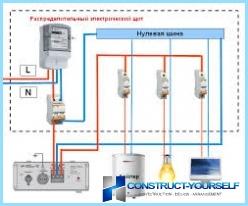
Also important aspect of selection is the quality of the batteries. They are the most expensive in this device, so you need to choose well-known brands with a warranty and the ability to find a replacement.
UPS for gas boilers ↑
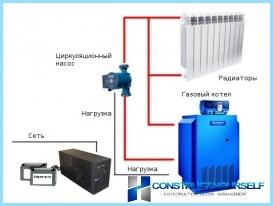
In principle, if you already have a UPS for the entire house, then buy another for the boiler makes no sense. But. if the first option for you can not afford, it is possible to purchase a separate UPS for the boiler. You should choose according to the criteria described above, the only difference is the capacity. You can take the UPS cheaper. Typically, for a boiler power of 500 W (0.5 kW) is enough, but better to see in the passport of your device. You need to consider not only the consumption of the electronics of the boiler, but the pumps too:
The choice of the UPS for the computer. ↑
This kind of UPS has long been used and received considerable popularity.
What to consider when selecting:
- famous brand with the possibility of replacement of the battery;
- a sufficient number of sockets output;
- alarm sound disabling external network;
- the fastest possible switching speed;
- time battery life;
- output power.
Generally, the heavier the unit the better. Take it is the one that weighs more with the same specified capacity in the case.
UPS for home and garden with his own hands ^ a
Yes, you can do it yourself. The easiest way to find an old computer UPS with a working battery and use the inverter and enclosure:
What else do you need?
- Remove the case.
- To disconnect the old battery and to make these insights with exit to the outside. For this, it is possible to make the housing hole and put the ends on the terminals. Now to these terminals to connect external batteries to the same voltage as the old one. Capacity the more the better.
- On the housing or on the rear panel-mounted sockets and connect them, first among themselves and then with the output of the inverter.
- Breaks off the on-Board speaker. Otherwise it would be constantly beeping.
- For better cooling of the cut in the housing hole on 120 mm and inserted into a standard fan. He needed to cool the inverter.
So you can build your own backup power system. The main thing is to choose a quality battery to voltage for the inverter. Calculate the tension can be old.
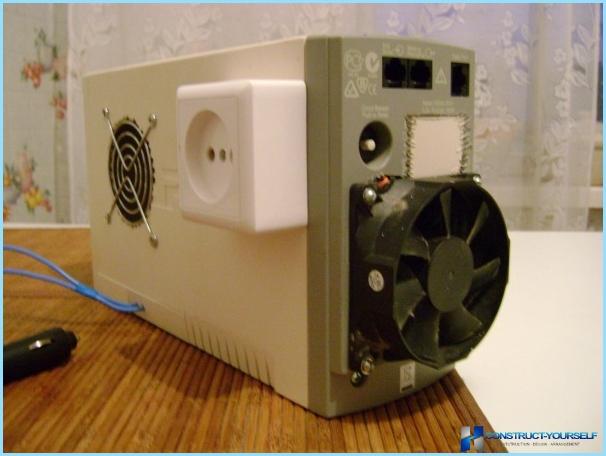
IPB undoubtedly the right thing. It will protect your equipment, and in emergency situations will not leave you in the dark. Even if you have blackouts, you should be ready now.


